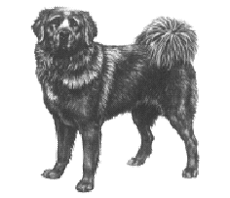Tibetan Mastiff
A breed standard is the guideline which describes the ideal characteristics, temperament, and appearance of a breed and ensures that the breed is fit for function with soundness essential. Breeders and judges should at all times be careful to avoid obvious conditions and exaggerations, as well as being mindful of features which could be detrimental in any way to the health, welfare or soundness of this breed.
Breed Standard - Tibetan Mastiff
 General Appearance:
General Appearance: The overall picture created is that of a large, powerful dog, sturdily built and well:balanced. His expression is alert and noble. The thick, heavily:feathered tail is carried high over the back, nicely balancing the head. The body is square with a distinctive double coat and a proudly worn ruff around the neck and shoulders extending to the occiput. Hair on the head is soft, silky and smooth.
Structure: The Tibetan Mastiff is a strong substantial animal with a heavy frame possessing the structure and configuration to provide stamina, speed and agility. He should never be so heavy as to appear coarse or clumsy nor so slight as to appear racy.
Height: Males: 66 to 71.1 cms (26 to 28 in.); Females: 60.9 to 66 cms (24 to 26 in.) at the withers. An oversized or undersized Tibetan Mastiff is to be penalised according to the extent of deviation.
Character: He is a courageous dog with strong protective instincts. He has spirit, initiative and courage, with no trace of timidity although he does take the time to size up a situation before acting. The Tibetan Mastiff possesses an excellent memory, is intelligent and easily trained, faithful, gentle with children and obedient. Although aloof with strangers, he has a desire to please and is a good-natured family companion, playful on invitation and generally impressive by his dignity upon reaching maturity.
Head: The head is perhaps the most notable feature of the Tibetan Mastiff. Head and shoulders must look substantial with a thick ruff, square and well:cushioned muzzle. The beauty of the head is emphasised by chiselling along the muzzle, around and beneath the eyes.
Skull: Broad, the crown somewhat arched when viewed from the side, with a well-developed or pronounced occiput and definite sloping stop. Slight median line extending back over the forehead. There is a definite furrow extending from the stop to halfway up the skull which becomes a ridge and extends to the occiput.
Muzzle: Wide and blunt and well:cushioned when viewed from the front. Neither coarse nor snippy. Muzzle is equal to 2/3 length of crown from stop to occiput. Clean cut, powerful and square in shape. The muzzle must have depth when viewed from the side.
Nose and Muzzle: Nose and lips black. Wide with well-developed nostrils. Upper lips pendulous. Lip line should not have the appearance of being coarse nor should the flews drop prominently at the corners of the mouth. Jaws strong and muscular, although the female’s jaws may be lighter. Strong, well-set teeth, snugly overlapping in a tight scissor bite or level. Undershot and overshot bites are undesirable.
Ears: Pendant, v:shaped, tips rounded. Carried low and close to the head, lifted away from head when at attention. When pulled forward, the tip of the ear reaches the inner corner of the eye on the same side. In the relaxed position, ears should hold their set and not cast backward. Leather is covered with short soft hair.
Eyes: Medium size, light to dark brown. Very bright, almond shaped, well:spaced with lower lid slanting upwards toward an imaginary point approximately at the base of the ears. Round or protruding eyes penalised. Set obliquely under moderately prominent supraorbital ridges. Eye rims black.
Neck: Strong, well:muscled, neck should slope to withers giving the impression of strength and dignity. Dog exhibits a pronounced crest of the neck when at attention. The neck gradually increases in circumference as it approaches the shoulder. Moderate dewlap in mature dogs, more pronounced in males.
Shoulders - Should lie close to the body, long and moderately sloping, well:muscled without being coarse. Reach well up to point of withers.
Chest: Deep and of medium width with pronounced sternum, ribs well sprung out from spine and flattened at the sides to allow proper movement of the shoulders and freedom from the front legs. Heart and lung room are secured more by body depth than width.
Topline: In the following descriptions the anatomical components of the spinal column have been described separately, i.e. withers, back, loin and croup.
Withers - Slope onto a level back.
Back - Straight, short and very strongly developed without sag or roach.
Loin - When viewed from top, broad and muscular. Loin slopes slightly upward to moderately pronounced hips. Loin is taut and broad, although narrower than rib cage and with moderate tuck-up. Ratio of back to loin is approximately 1:2.
Croup - Must be full, slightly sloping but never so steep as to restrict rear movement and must continue imperceptibly to the tail root.
Tail: Moderately long. Profusely feathered with thick, long hair and carried forward in a plume over the back. Sometimes dropped at rest. Judges should see tail up at least once.
Forelegs - Firm front, strong bone. Legs should be parallel and straight to the pasterns. The pasterns should be strong, sturdy and slightly sloping to give flexibility and spring for proper let:down of feet. The slope should not start at the joint but below it. The slope should always be sufficient to bring the heel of the pad under the centre of gravity. Length of leg from ground to elbow should be 50—55% of total height at withers. A very short:legged dog is to be penalised.
Hindquarters: Powerful and well:muscled. Two thirds of rear leg is between hock and hip. Upper thighs well:developed and slightly bowed from hock to crotch. As endurance is of greater consequence than speed, the stifle is slightly bent.
Feet: Large, compact, hare:foot, slightly spread but not splayed. The second and third digits may be relatively longer but the foot should lose none of its compactness. The forefeet are larger than the hind feet, toes arched, pads thick and tough.
Gait and Movement: Should be free, agile and vigorous, showing great elasticity and spring in the smooth, powerful stride. From the standing position, as the Tibetan Mastiff moves the pads converge to a single track beneath the actual centre of the dog. The marked single track gait of a well-built Tibetan Mastiff should never be mistaken for the gait fault of “moving close”. The Tibetan Mastiff works at a canter and often uses the double suspension gallop. He must be sure of foot in any kind of going. Ability to turn quickly and initial spring are desirable qualities. Moving with head and tail held high, the whole appearance of the Tibetan Mastiff is one of great style, grace and beauty.
Coat: Body is covered with an undercoat of soft, short, dense wool with longer and harsher hair growing through it to form the outer coat. The coat texture is heavy around the neck, shoulders and down the back to the tail. Coat on legs, side and stomach is shorter in length and somewhat lighter in texture. It is that heavy texture of the neck and shoulders that gives the impression of a lion’s mane. Undercoat is shed with the advent of warm weather making quality of coat harder to judge during hotter months and in warmer climates. When in full coat, undercoat should be so dense as to make it almost impossible to see skin.
Colour:
- Blacks - Blacks may vary in colour from shining all black to a slight tinge of bronze with variations in the shading. Silvering may appear in the undercoat, tail, underparts of the dog, or beneath the tail and breechings. White on the chest is permissible.
- Golds - This colour may vary from a deep cinnamon red to a light golden to a pale cream colour with variations in the shading of the coat on ears, body, tail, underparts of the dog, or beneath the tail and breechings. White on chest is permissible.
- Black and Tans - Shining black with clearly defined markings on cheeks, muzzle, chest, legs and below tail, as well as over both eyes. Colour of markings from rust to light tan. White on chest permissible.
- Silver Greys - Coat from dark shining grey to silver grey. Rust to light tan markings the same as for the black and tans. White on chest permissible.
Faults: A dog with an uncontrollable or vicious temperament in the ring should be disqualified by judge. Overall shaggy coat, lack of symmetry and balance in movement, well:bent stifles, barrel legs or pigeon toes, mincing, shuffling, crabbing, weaving or a hackney action are all faults.
Summary: This is a well-balanced dog with ease and freedom of movement, with an imposing head shoulders and chest. Both the dog and the bitch give the appearance of great endurance. Obvious structural faults common to all breeds, are undesirable in the Tibetan Mastiff as in any other breed, even though they are not specifically mentioned in this Standard.
Note: Male animals should have two apparently normal testicles fully descended into the scrotum.
DNZ No 697
Dogs New Zealand
01 Jan 2002
Any departure from the foregoing points should be considered a fault and the seriousness with which the fault should be regarded should be in exact proportion to its degree and its effect upon the health and welfare of the dog and on the dog’s ability to perform its traditional work.




